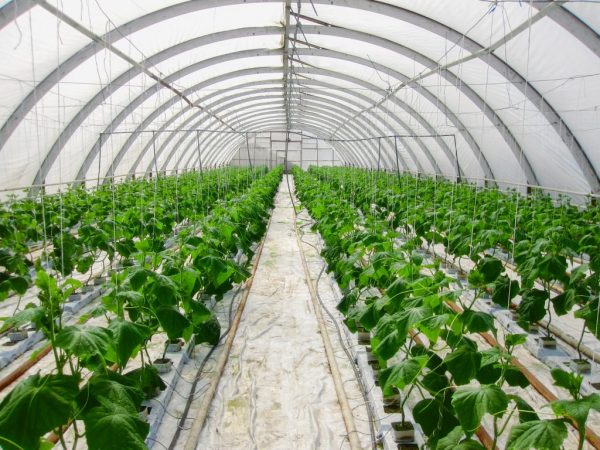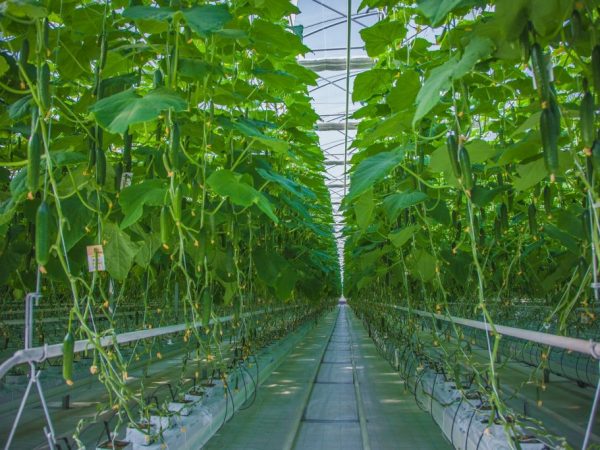The use of hydroponics for growing cucumbers
Hydroponics for cucumbers is a vegetable cultivation technology that increases the yield and saves the area required for planting. Specialty stores offer ready-made hydroponic devices, but they are easy to make yourself at home.

The use of hydroponics for growing cucumbers
Hydroponic cultivation
DIY hydroponics for cucumbers and tomatoes allows you to grow vegetables throughout the calendar year. The package includes a special solution, saturated with nutrients, necessary for the growth and development of vegetable crops.
The nutrient solution used in hydroponic devices is selected individually for each individual vegetable crop.
The liquid used in the hydroponic system contains no chemical components and stimulants. For its production, natural organic matter is used, which helps in the growth and development of ripening of cucumbers and tomatoes.
Varieties of hydroponics
DIY hydroponic devices for cucumbers:
- structure with periodic flooding;
- drip system;
- device on a mineral wool substrate.
Benefits of hydroponic cultivation
There are a number of advantages to growing cucumbers at home using DIY hydroponics.
- Rapid development of vegetable crops. Cucumber bushes in hydroponic cultivation are developing at a rapid pace, because practically not damaged by diseases typical for cucumbers. They receive all the necessary mineral elements in full. The culture increases immunity and productivity. In the case of a properly selected nutrient component, the plantings will not dry out or rot.
- Simplification of care. When growing cucumber using a hydroponic device, there is no need to water the beds and apply fertilizers every day. All nutrition is supplied to the plants in metered doses, which protects the cucumber plantings from overfeeding with fertilizers or from their insufficiency. Treatment of plantings from pests spreading through contaminated soil is not required. There is no need to remove weeds.
- Saves space and water. Growing cucumbers and tomatoes on hydroponic devices can save a significant part of the area required for growing vegetables under normal conditions. The water consumed during conventional irrigation is also significantly saved.
- No need for fertile soils. This method of growing cucumbers and tomatoes does not require the use of soil, therefore it is well suited for those regions in which infertile soils do not make it possible to obtain large yields of vegetables.
When cultivating vegetables on a homemade hydroponic device, gardeners face a number of difficulties, including the need to purchase equipment from which they make a home structure, study the technological process of its manufacture, familiarize themselves with nutritional compositions, control the temperature during growing and monitor the liquid level in the device.
How to make a flooded system

The system can be made by hand
You can make an effective hydroponic structure with flooding with your own hands from available tools:
- expanded clay,
- plastic pipes where holes are drilled,
- crushed stone,
- pump or pump,
- compost (humus with fertile soil),
- water.
The holes in the plastic pipes are made in accordance with the size of the containers where the cucumbers will grow. In these containers, instead of the soil soil usual when planting vegetables, expanded clay and a little crushed stone of the middle fraction are poured.
When cultivating cucumber on an industrial scale, pumps are installed in hydroponic devices. Some gardeners use pumping structures in their summer cottages, wishing to get large yields.
To feed the seedlings, the fertilizing liquid is prepared independently or purchased ready-made in special stores. In the first case, you should have the necessary knowledge about fertilizer complexes and manufacturing technology.
The design with periodic addition of liquid is suitable for the cultivation of cucumber in a summer cottage in a greenhouse or in the basement of a private house.
The mineral feeding solution is poured into compost for a day, then it is poured into a separate bowl. This is a working fluid, which is pumped into the plastic pipes with the help of a pump or pump, where containers with seedlings are placed.
How to make a drip hydroponic device
Drip hydroponic devices are more often used when cultivating vegetables in an apartment on a windowsill or on a balcony loggia. It does not use compost in order to avoid odors in an enclosed space.
The effective operation of the drip system is in demand not only among private homeowners, but also on agricultural farms and agricultural enterprises.
For self-production of the structure you will need:
- sealed containers - 2 pieces,
- containers for seedlings,
- water pump,
- timer,
- overflow device,
- flexible plastic tubes.
Sealed containers must be placed one above the other:
- a hole is made in the upper one, through which the feeding solution, coming there from containers with seedlings, will begin to leave through the tube,
- a pump is installed in the lower one, its task is to feed the liquid feeding the seedlings through the tube back into the tank with the installed containers with the seedlings.
Mineral water construction
The simplest substrate for hydroponic devices in the cultivation of cucumbers is expanded clay material, but it often changes alkaline parameters, adversely affecting the growth and development of seedlings and reducing the amount of vegetable yield.
Gardeners began to replace expanded clay with special mineral wool, which simplifies the process of cultivating vegetable crops. This material, when used in structures, enables the root system of plants to grow inside mineral fibers, keeping the moisture and nutrients required for them in the cotton wool. Thanks to the ventilation of the mineral fibers, rotting of the sprouts is completely excluded.
For systems it is possible to use plain mineral wool or mineral substrates specially developed for hydroponics.
Some varieties of mineral water substrates make it possible to use full immersion in a mineral liquid for the classic technology of growing vegetables, in which food circulates through plastic pipes in which containers with seedlings are installed.
Conclusion
Using homemade hydroponic devices for planting cucumbers and tomatoes can simplify planting maintenance and ensure high yields. At the same time, you can choose the most affordable method for manufacturing a small-volume or large-scale structure, based on the individual conditions for the placement of landings. Homemade systems can be replaced with ready-made mechanisms, among which Aquapot products are best known, offering a wide range of hydroponic plants.


